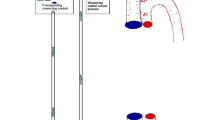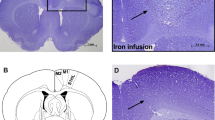Summary
Twenty mongolian gerbils were anesthetized (1.5% halothane) and severe forebrain ischemia was produced in 15 animals by occluding both common carotid arteries. After 5 min ischemia brains were recirculated spontaneously. Immediately after ischemia nimodipine (1.5 mg/kg) or pentobarbital (50 mg/kg) was injected intraperitoneally into five animals. Four days later animals were reanesthetized (1.5% halothane); the brains were frozen with liquid nitrogen and cut in a cryostat. Ten-micrometer-thick coronal cryostat sections were stained with cresyl violet to assess the extent of ischemic cell damage in the lateral striatum, the CA1-layer of the hippocampus, and the thalamus. In addition, tissue samples (about 4 mg each) were taken from the lateral striatum, CA1 layer of the hippocampus and the thalamus. Putrescine levels were measured in these samples using reversed-phase high performance liquid chromatography and fluorescence detection. Reversible cerebral ischemia produced a significant increase in putrescine in the lateral striatum (from 11.15±0.79 to 44.83±11.76 nmol/g,P≤0.05), the CA1 subfield of the hippocampus (from 11.27±0.64 to 41.80±3.62 nmol/g,P≤0.05) and less so in the thalamus (from 11.28±0.70 to 16.50±1.71 nmol/g). Both postischemic nimodipine and barbiturate treatment of animals markedly reduced this increase in the lateral striatum to 14.09±1.41 and 15.75±1.38 nmol/g, respectively (P≤0.05 cf. untreated animals), to 29.82±6.04 and 23.21±3.12 nmol/g in the CA1-subfield of the hippocampus (P≤0.05 barbiturate-treated cf. untreated animals), and to 11.92±1.37 and 11.76±0.64 in the thalamus (P<0.05 barbiturate-treated cf. untreated animals). Severe neuronal necroses were apparent in the lateral striatum in four out of five animals but in none of the nimodipine- or barbiturate-treated animals. In the CA1 subfield of the hippocampus the number of necrotic cells/mm stratum pyramidale amounted to 202.1±9.8, 141.9±4.2 and 78.0±33.4 in untreated, nimodipine- or barbiturate-treated animals, respectively (P≤0.05 barbiturate-treated cf. control animals). It is suggested that putrescine, produced during recirculation following ischemia, contributes to the manifestation of ischemic cell injury. Putrescine may thus be taken as a significant biochemical correlate of ischemic cell damage.
Similar content being viewed by others
References
Arai H, Passonneau JV, Lust WD (1986) Energy metabolism in delayed neuronal death of CA1 neurons of the hippocampus following transient ischemia in the gerbil. Metabol Brain Dis 1:263–278
Bazán NG (1970) Effect of ischemia and electroconvulsive shock on free fatty acid pool in the brain. Biochim Biophys Acta 218:1–10
Bell JM, Madwed DS, Slotkin TA (1986) Critical development periods for inhibition of ornithine decarboxylase by α-difluoromethylornithine: effects on ontogeny of sensorimotor behavior. Neuroscience 19:457–464
Bondy SC, Walker CH (1986) Polyamines contribute to calcium-stimulated release of aspartate from brain particulate fractions. Brain Res 371:96–100
Canellakis ES, Viceps-Madore D, Kyriakidis DA, Heller JS (1979) The regulation and function of ornithine decarboxylase and of the polyamines. Curr Top Cell Regul 15:155–202
Dempsey RJ, Maley B, Olson J, Cowen DE, Maley M, Roy MW (1987) Ornithine decarboxylase activity and immunohistochemical location in postischemic brain. J Cereb Blood Flow Metab [Suppl 1] 7:S73
Dienel GA, Cruz NF, Rosenfeld SJ (1985) Temporal profiles of proteins responsive to transient ischemia. J Neurochem 44:600–610
Djuricic BM, Paschen W, Schmidt-Kastner R (1988) Polyamines in the brain: HPLC analysis and its application in cerebral ischemia. Jugosl Physiol Pharmacol Acta (in press)
Ferchmin PA, Eterovic VA (1987) Role of polyamines in experience-dependent brain plasticity. Pharmacol Biochem Behav 26:341–349
Flamm ES, Demopoulos WB, Seligman ML, Poser RG, Ransohoff J (1978) Free radicals in cerebral ischemia. Stroke 9:445–447
Gaudet JR, Alam I, Levine L (1980) Accumulation of cyclooxigenase products of arachidonic acid metabolism in gerbil brain during reperfusion after bilateral common carotis artera occlusion. J Neurochem 35:653–658
Greenough WT, Hwang H-MF, Gorman C (1985) Evidence for active synapse formation or altered postsynaptic metabolism in visual cortex of rats reared in complex environments. Proc Natl Acad Sci USA 82:4549–4552
Hallmayer J, Hossmann K-A, Mies G (1985) Low dose of barbiturates for prevention of hippocampal lesions after brief ischemic episodes. Acta Neuropathol (Berl) 68: 27–31
Heby O (1981) Role of polyamines in the control of cell proliferation and differentiation. Differentiation 19:1–20
Iqbal Z, Koenig H (1985) Polyamines appear to be second messengers in mediating Ca2+ fluxes and neurotransmitter release in potassium-depolarized synaptosomes. Biochem Biophys Res Commun 133:563–573
Jänne J, Pösö H, Raina A (1978) Polyamines in rapid growth and cancer. Biochim Biophys Acta 473:241–293
Jørgensen MB, Diemer NH (1982) Selective neuronal loss after cerebral ischemia in the rat: possible role of transmitter glutamate. Acta Neurol Scand 66:536–546
Kirino T (1982) Delayed neuronal death in the gerbil hippocampus following ischemia. Brain Res 329:57–69
Kleihues P, Hossmann K-A, Pegg AE, Kobayashi K, Zimmermann V (1975) Resuscitation of the monkey brain after one hour of complete ischemia. III. Indications of metabolic recovery. Brain Res 95:61–73
Koenig H, Goldstone A, Lu CY (1983) Polyamines regulate calcium fluxes in a rapid membrane response. Nature 305:530–534
Koenig H, Goldstone A, Lu CY (1983) β-Adrenergic stimulation of Ca2+ fluxes, endocytosis, hexose transport, and amino acid transport in mouse kidney cortex is mediated by polyamine synthesis. Proc Natl Acad Sci USA 80:7210–7214
Koenig H, Goldstone A, Lu CY (1983) Blood-brain barrier breakdown in brain edema following cold injury is mediated by microvascular polyamines. Biochem Biophys Res Commun 116:1039–1048
Komulainen H, Bondy SC (1987) Transient elevation of intrasynaptosomal free calcium by putrescine. Brain Res 401:50–54
Mies G, Paschen W, Hossmann K-A, Klatzo I (1983) Simultaneous measurement of regional blood flow and metabolism during maturation of hippocampal lesions following short-lasting cerebral ischemia in gerbils. J Cereb Blood Flow Metab [Suppl 1] 3:S329-S330
Paschen W, Schmidt-Kastner R, Djuricic B, Meese C, Linn F, Hossmann K-A (1987) Polyamine changes in reversible cerebral ischemia. J Neurochem 49:35–37
Paschen W, Hallmayer J, Mies G (1987) Regional profile of polyamines in reversible cerebral ischemia in Mongolian gerbils. Neurochem Pathol 7:143–156
Pegg AE (1986) Recent advances in the biochemistry of polyamines in eukaroytes. Biochem J 234:249–262
Petito CK, Barbiak T (1982) Early proliferative changes in astrocytes in postischemic noninfarcted rat brain. Ann Neurol 11:510–518
Plum F (1983) What causes infarction in ischemic brain? The Robert Wartenberg Lecture. Neurology 33:222–233
Rothman S (1983) Synaptic activity mediates death of hypoxic neurons. Science 220:536–537
Schindler J, Kelly M, McCann PP (1985) The response of several murine embryonal carcinoma cell lines to stimulation of differentiation by α-difluoromethylornithine. J Cell Physiol 122:1–6
Seiler N (1981) Polyamine metabolism and function in the brain. Neurochem Int 3:95–110
Siesjö BK (1981) Cell damage in the brain: a speculative synthesis. J Cereb Blood Flow Metab 1:155–185
Slotkin TA, Bartolome J (1986) Role of ornithine decarboxylase and the polyamines in nervous system development: a review. Brain Res Bull 17:307–320
Suzuki R, Yamaguchi T, Kirino T, Orzi F, Klatzo I (1983) The effects of 5-minutes ischemia in the Mongolian gerbils. I. Blood-brain barrier, cerebral bloow flow and local cerebral glucose utilization changes. Acta Neuropathol (Berl) 60:207–216
Trout JJ, Koenig H, Goldstone AD, Lu CY (1986) Blood-brain barrier breakdown by cold injury. Polyamine signals mediate acute stimulation of endocytosis, vesicular transport, and microvillus formation in rat cerebral capillaries. Lab Invest 55:622–631
Turner A, Greenough WT (1985) Differential rearing effect on rat visual cortex synapses. I. Synaptic and neuronal density and synapses per neuron. Brain Res 329:195–203
Volkmar FR, Greenough WT (1972) Rearing complexity affects branching of dendrites in the visual cortex of the rat. Science 176:1445–1447
Wieloch T (1985) Neurochemical correlates to selective neuronal vulnerability. Prog Brain Res 63:69–85
Wieloch T, Lindvall O, Blomquist P, Gage F (1985) Evidence for amelioration of ischemic neuronal damage in the hippocampal formation by lesions of the perforant path. Neurol Res 7:24–26
Author information
Authors and Affiliations
Additional information
Supported by the Deutsche Forschungsgemeinschaft, grant Pa 266/2-4
Rights and permissions
About this article
Cite this article
Paschen, W., Hallmayer, J. & Röhn, G. Relationship between putrescine content and density of ischemic cell damage in the brain of mongolian gerbils: effect of nimodipine and barbiturate. Acta Neuropathol 76, 388–394 (1988). https://doi.org/10.1007/BF00686976
Received:
Revised:
Accepted:
Issue Date:
DOI: https://doi.org/10.1007/BF00686976




